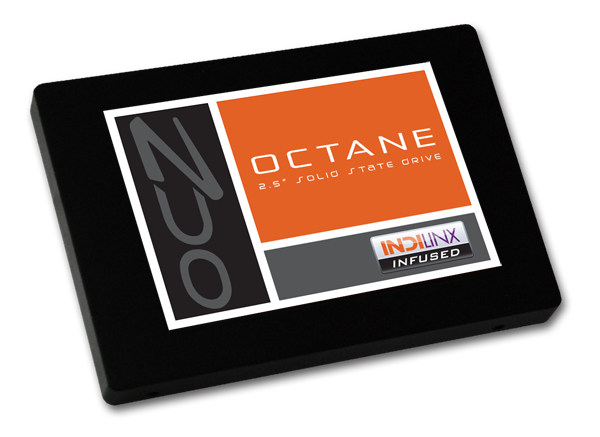OCZ's Octane SSD: Indilinx Everest, Up to 1TB in a Consumer Drive
by Anand Lal Shimpi on October 20, 2011 9:00 AM ESTIn March, OCZ signed a definitive agreement to acquire Indilinx, the SSD controller company that pretty much dominated the value segment in 2009 before Intel got aggressive on pricing and SandForce took over the high-end. Indilinx was late on releasing its 6Gbps SSD controller prior to the acquisition and had all but fallen off the radar as most of its partners jumped ship to SandForce. OCZ scooped up the company with hopes of developing its own controllers and rising above the memory-manufacturer-turned-SSD-player crowd.
SandForce has obviously extended its reach since OCZ announced its intentions, partnering with many of OCZ's competitors in an attempt to expand its reach as well as lessen dependence on OCZ. As a customer turned competitor, SF like many of us knew that an OCZ SSD boasting a new Indilinx controller was in the works. Today we have the first details on that solution and it's called Octane.
Based on the Indilinx Everest controller, OCZ is touting incompressible data and sustained write performance as the two major strengths of Octane - obviously a jab SandForce and traditional SSD weaknesses. The controller is paired up with up to a 512MB DRAM cache, indicating that it is taking the more traditional route of storing both user data as well as page mapping tables in DRAM. There's no mention of power protection circuitry to flush the cache contents to NAND in the event of a power failure, but given the target market for these drives I don't suppose we'll see such a feature.
The Octane will be available in two discrete versions: one with 6Gbps SATA support and one limited to 3Gbps (SATA 3.0 and 2.0, respectively). The 6Gbps version will ship with 25nm IMFT synchronous NAND, while the 3Gbps version will use 25nm IMFT async NAND similar to the Vertex 3/Agility 3 divide today. Sequential read/write speeds are competitive at 560/400 MBps, while 4KB random read/write speeds are quoted at 45K/25K.

Capacities start at 128GB and will go all the way up to 1TB. OCZ is expecting pricing to fall somewhere within the $1.10 - $1.30 per GB range, which would put a 128GB drive at no more than $166 (in line with current Vertex 2 pricing) and a 1TB drive at just over $1300. Spare area is set at the standard ~7% you get from the GiB to GB conversion. No word on whether or not there's any additional NAND set aside for redundancy.
The Everest controller features 8 NAND channels and up to 16-way interleaving. With 25nm NAND that means peak performance should be achievable with the 128GB model, with the larger drives just offering higher capacity and no additional performance. TRIM is of course supported. OCZ indicates support for both standard wear leveling and background garbage collection (presumably at idle time).
The first Octane drives will be available in the channel starting November 1st. I've already dispatched a huge list of questions to OCZ about the controller and the drive's architecture so I'll update this post as I get any new information. And of course, once we get a review sample I'll begin extensive testing.
















50 Comments
View All Comments
Squidward - Thursday, October 20, 2011 - link
Looking forward to see how this compares to SandForce, just might have some real competition with these new SSD Drives from OCZ,FunBunny2 - Thursday, October 20, 2011 - link
What are they thinking? User data in DRAM and no net underneath?davepermen - Thursday, October 20, 2011 - link
who could have though OCZ would do something like this? :)josephjpeters - Thursday, October 20, 2011 - link
People should be backing up with an external. If you have a Mac, go buy a Time Capsule so you don't even have to think about back up.jmke - Thursday, October 20, 2011 - link
I don't see how an external data backup will prevent data loss when that 512Mb CACHE memory falls without power....Sunburn74 - Thursday, October 20, 2011 - link
Can't you have window's automatically flush the cache after all writes?Sivar - Thursday, October 20, 2011 - link
Yes, and Linux can do the same by mounting the filesystem as "sync" (synchronous). Doing so does sort of defeat a lot of the benefit of having a large data cache, though.Ideally, the SSD should have enough backup power, via capacitors or other, to write the entire contents of cache during a power outtage.
DanNeely - Thursday, October 20, 2011 - link
Don't normal drives write their ram cache out as quickly as they can though? In that case you're really not getting much beyond a warm and fuzzy feeling from the latency added to all your IO.stoggy - Saturday, October 29, 2011 - link
if its that important to you, buy a ups?FunBunny2 - Thursday, October 20, 2011 - link
That would mean you could restore, if the drive isn't totally hosed, from your last backup. Unless you're advocating tiered storage managed by the user?